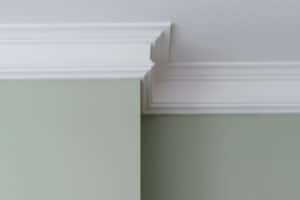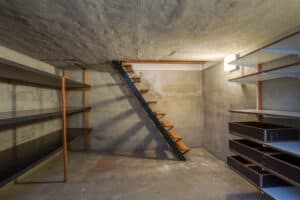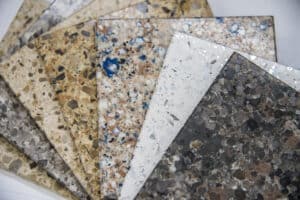
Drywall mud can help you fix an imperfection in your walls.
The product is easy to use, and it can be applied quickly and easily.
Drywall mud has a shelf life and should not be used if there are any issues or imperfections with the product.
Let’s take a look at some of these issues and whether or not you should be using your drywall mud.
Can You Use Drywall Mud that Has Mold?

You cannot and should not use drywall mud that has mold.
The mold in the product means that it has gone bad.
Since the product is no longer good, it can actually apply the mold to the wall and create more problems for you.
Some experienced professionals will say that they simply pick the mold out of the container and apply the mud anyway.
Yes, there is a chance that, if you do this, things will be fine.
However, it is a small chance and one that is not worth taking.
If you think that your drywall mud has mold on it, close the lid and dispose of the product.
Not only is it unsafe for you to put this mold on your walls, but it could be unsafe to work with as well.
Many people end up getting sick from being exposed to mold.
Not that wasting is a great thing to do, but the cost for drywall mud is not all that expensive, and you can replace your container quite easily if needed.
Why Does Mold Grow on Drywall Mud?

If you purchase a large five-gallon container of drywall mud, you will probably have to store it for a while.
It’s hard to go through five gallons of this product at a time.
Sometimes, when you store the drywall mud, there are no issues with it.
However, other times, when you open the container back up, it is covered in mold.
This is unfortunate and quite annoying as well.
Mold will grow anywhere that it can get food.
The food that mold needs to grow is something that has a lot of moisture.
Many times, there will be a lot of moisture throughout the drywall mud.
When the lid goes on the product and the mud is stored in a warm environment, this is the perfect condition to create condensation and trap more water inside.
These conditions lead to mold growth, and you won’t even know it is going on.
The next time you open your container, you will be left with a disappointing surprise.
There are, however, some ways to make sure that mold does not grow on your drywall mud.
Steps to Keep Mold from Growing on Drywall Mud

If you can keep mold from growing on your drywall mud, you can keep it in excellent condition for quite a bit longer.
Taking these simple steps to keep mold from growing on drywall will help to ensure that you protect your drywall mud for as long as possible.
Unfortunately, drywall mud does have a lifespan, and it will not last forever.
However, you can follow these steps to keep mold away.
Step 1: Gather Supplies
The first step of this process is to gather the supplies you will need to complete the job.
You will need to have your drywall knife to help you clean up the bucket.
We like to clean the knife before using it to get the bucket situated.
It’s good to know that the knife is clean so that there are no additional bacteria left in the container.
In addition, you will also need some bleach and a rag.
It’s a good idea to have a large plastic bag and a hammer as well.
Once you have these supplies in place, you can move on to the next steps.
- Bleach
- Rag
- Plastic Lid
- Plastic Bag
- Hammer
Step 2: Smooth Out
Once you have all your supplies in place, you are going to want to smooth out the drywall that you have in your bucket.
Many times, when you are using drywall mud, it gets a bit sloppy in the bucket.
Pieces will be stuck to the side, and the top will not be smooth or even.
You will want to get this all off the sides and smooth out the top layer of the mud.
If you leave small pieces of drywall mud on the side of the bucket at the top, you could end up seeing those get mold, and that mold will spread.
It only takes a minute to get the mud smoothed out and flattened out inside the bucket.
Once you have the top of the drywall mud flat and looking like a brand-new can, you can move to the next step.
Step 3: Plastic
Chances are your drywall mud came with a plastic sheet on the top of the container.
You should have saved this sheet.
The reason the plastic was there was to help make sure the product did not get moldy before it was sold to you.
You can take this plastic piece and press it lightly on top of your smoothed out drywall mud.
This plastic should be the perfect size for your container.
If you don’t have this piece anymore for some reason, you can use a piece of plastic cut to the size of the bucket.
This will help seal things in and keep more moisture from accumulating in an area you don’t want it to.
Step 4: Rag with Bleach
Next, you are going to want to soak a rag in a solution of one part bleach and two parts water.
Let the rag sit in there for just a minute or two, and then take it out and wring the rag so that it is not dripping water.
If you are sensitive to bleach, you may want to wear a pair of gloves when you do this.
A bit of the bleach will end up on your hands, and for some people, this is unpleasant.
You will notice that the rag takes on the smell of bleach as well, but this is okay, and the smell will start to dissipate rather quickly.
Take the rag, which should be damp but not soaking wet, and place it on top of the plastic in the drywall mud bucket.
Lay the rag out flat and make sure it is covering as much of the plastic as possible.
We do recommend making sure that the rag is in a single layer over the top of the plastic and not bunched up.
Once you have this in place, you are ready to move to the next step and start closing up the bucket.
Step 5: Close Lid and Seal
Take the lid that came with your drywall mud and place it on top of the bucket.
If this is a larger bucket, chances are you will have to use a hammer to get the top on tightly.
It is hard to snap on these larger tops without the help of the hammer.
You should hear the top click in all around the top so that it is sealed.
Remember that you will not be able to get the container back to its original condition.
You cannot create the factory seal again, and because of that, you need to take some extra precautions.
The best thing to do is to put a plastic bag over the top of the bucket.
The bag is not going to be a perfect seal either, but the combination of the top and the plastic bag seal will undoubtedly help.
If you have something that can fit tightly around and help to seal the bucket even further, we recommend using it.
For smaller drywall mud containers, it would be a great idea to put a rubber band or two around the top before storing the entire thing inside a plastic bag.
Just remember that the more air and moisture that come in from the outside, the harder it is going to be to keep the product in good condition.
When you have put the plastic bag in place, you can move to the final step.
Step 6: Store in Temperature-Controlled Environment
Last but certainly not least, you will want to make sure that you store your drywall mud in a temperature-controlled environment.
If you put this bucket out in a shed where it is exposed to a wide range of temperatures, you could experience more mold issues.
Look for an area of your home that has a more temperature-controlled environment.
Sometimes, a garage is a good place, depending on the range of temperatures in your garage.
Some will store it in the basement, but you must remember that basements typically have higher levels of moisture.
If you are going to store it in your basement, make sure that you check on it often to see if it is a good place for storage.
Does Moldy Drywall Need to Be Replaced?

By now, you know that we don’t recommend using moldy drywall mud as it can transfer to the drywall.
The reason you never want your drywall to get moldy is that it can cause major problems in your home.
If your drywall gets moldy, you will need to replace it entirely.
The reason is that the mold is impossible to remove, and it will spread to the other areas in your home.
If you’re lucky and catch the mold issues early, you may be able to replace small sections.
However, if you don’t catch this quickly, it could spread throughout the home.
For an issue this severe, you will want to make sure that you don’t introduce the mold to your home.
The last thing you want to do is to make this harder on yourself.
Simply running to the store and grabbing a container of drywall mud that is fresh and bacteria free is the way to go.
You will be glad that you did so when your walls are in great shape for years to come.
Conclusion
As you can see, the risk of using drywall mud with mold on it is simply not worth it.
You are putting your entire home in danger and setting yourself up for a much more difficult process and removal.
Instead, you should simply purchase new drywall mud to put on your walls.
If you have a large container of drywall mud and want to make sure it doesn’t get moldy, follow our steps for success.
These steps will make a big difference in preventing the accumulation of mold.
Try and make sure that you purchase drywall mud in a container size that you know you will use in a relatively short period of time.
Letting drywall mud sit for months or years will be challenging to keep in excellent condition.



Leave a Reply